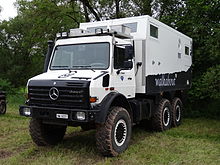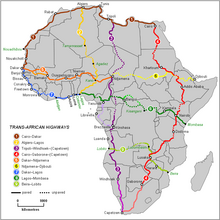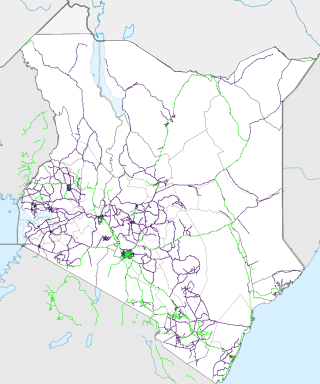
Transport in Kenya refers to the transportation structure in Kenya. The country has an extensive network of paved and unpaved roads.

The Gunbarrel Highway is an isolated desert track in the Northern Territory, South Australia and Western Australia. It consists of about 1,350 km (840 mi) of washaways, heavy corrugations, stone, sand and flood plains. The Gunbarrel Highway connects Victory Downs in the Northern Territory to Carnegie Station in Western Australia. Some sources incorrectly show the highway extending west to Wiluna.
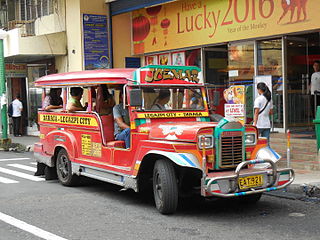
A share taxi is a mode of transport which falls between a taxicab and a bus. These vehicles for hire are typically smaller than buses and usually take passengers on a fixed or semi-fixed route without timetables, but instead departing when all seats are filled. They may stop anywhere to pick up or drop off their passengers. Often found in developing countries, the vehicles used as share taxis range from four-seat cars to minibuses. They are often owner-operated.

Victoria Falls, popularly known as Vic Falls, is a resort town and city in the province of Matabeleland North, Zimbabwe. It lies on the southern bank of the Zambezi River at the western end of Victoria Falls themselves. According to the 2022 Population Census, the town had a population of 35,199.
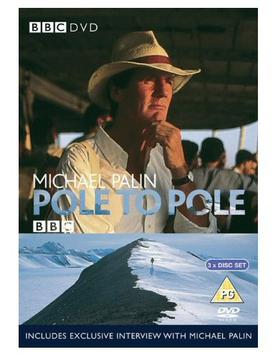
Pole to Pole with Michael Palin is an eight-part television documentary travel series made for the BBC, and first broadcast on BBC1 in 1992. The presenter is Michael Palin, this being the second of Palin's major journeys for the BBC. The first was Around the World in 80 Days with Michael Palin, a 7-part series first broadcast on BBC One in 1989, and the third was Full Circle with Michael Palin, a 10-part series first broadcast on BBC One in 1997.

Moyale is a city on the border between Ethiopia and Kenya. In Ethiopia, Moyale is the administrative centre for two Ethiopian woredas, Moyale of the Oromia Region and Moyale of the Somali Region. In Kenya, it is the largest town of Marsabit County and the capital of Moyale sub-county.

Isiolo is a town in Isiolo County, of which it is the capital. It is located in the upper eastern region of Kenya and is geographically considered the center of the country Kenya. It lies 285 kilometers north of the capital Nairobi. The town grew around the local military camps, much of the population being Ameru community, Borana, and the descendants of former Somali soldiers who had fought in World War I. The town has an estimated population of 78,250, most of them living around the outskirts of the town. Like most African cities, there has been a steady increase in the urban population in recent years, especially moving from as far as Moyale, Marsabit and Mandera. Isiolo town is also becoming a centre of interest because of its newly acquired status as a resort city cashing in on the popular Samburu and Shaba Game reserves, which have become preferred destinations after the famed Maasai Mara. Isiolo lies along the long A2 Road, leading towards Marsabit and Moyale much further north.
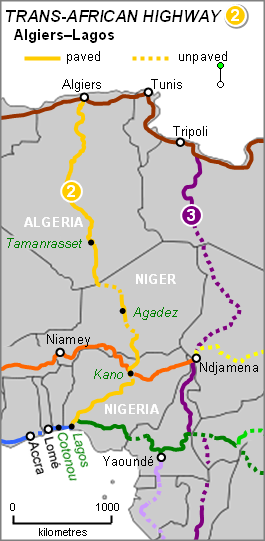
The Trans-Sahara Highway or TAH 2, also known as the African Unity Road, is a transnational highway project nearing completion to pave, improve and ease border formalities on an existing trade route running north–south across the Sahara Desert. It runs between North Africa bordered by the Mediterranean Sea in the north and West Africa bordered by the Atlantic Ocean in the south, from Algiers in Algeria to Lagos in Nigeria, giving it the alternative names of the Algiers–Lagos Highway or Lagos–Algiers Highway.
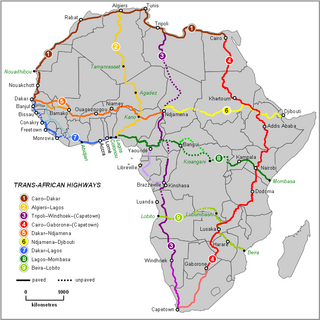
The Trans-African Highway network comprises transcontinental road projects in Africa being developed by the United Nations Economic Commission for Africa (UNECA), the African Development Bank (ADB), and the African Union in conjunction with regional international communities. They aim to promote trade and alleviate poverty in Africa through highway infrastructure development and the management of road-based trade corridors. The total length of the nine highways in the network is 56,683 km (35,221 mi).

The T1 or Lusaka–Livingstone Road is the main highway of the Southern Province of Zambia. It begins 55 kilometres south of the city of Lusaka and heads south-west to the principal tourist destination, Victoria Falls in Livingstone, via Mazabuka, Monze, Choma and Kalomo, measuring approximately 430 kilometres (267 mi). The entire route is part of Trans-African Highway network number 4 or Cairo-Cape Town Highway between Cairo and Cape Town.
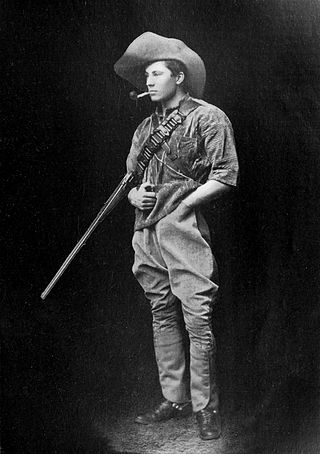
Ewart Scott Grogan (1874–1967) was an English explorer, politician, and entrepreneur. He was the first person in recorded history to walk the length of Africa, from Cape Town to Cairo.

The Cairo–Cape Town Highway is Trans-African Highway 4 in the transcontinental road network being developed by the United Nations Economic Commission for Africa (UNECA), the African Development Bank (AfDB), and the African Union. The route has a length of 10,228 km (6,355 mi) and links Cairo in Egypt to Cape Town in South Africa.

The Gary Junction Road is an outback unsealed road in Australia built by Len Beadell in the 1960s as part of a network of roads for the Weapons Research Establishment at Woomera, South Australia. In its original form, the Gary Junction Road ran from Liebig bore in the Northern Territory to Callawa Station in Western Australia. On present day maps, it is depicted as running from the Tanami Road to Gary Junction, just east of the Canning Stock Route, a distance of 852 kilometres. The road was named after Beadell's only son Gary.

The Talawana Track is a remote unsealed track that runs between Windy Corner on the Gary Highway and the Marble Bar Road in Western Australia, a distance of 596 kilometres. The majority of it was built by Len Beadell and the Gunbarrel Road Construction Party in 1963 as part of a series of connecting roads for the Woomera rocket range in South Australia. It was the final road they built.

Mount Davies Road is a remote unsealed outback track which runs from Mount Davies (Pipalyatjara) in the far north-west corner of South Australia to Anne's Corner on the Anne Beadell Highway 397 kilometres to the south-east. It was built during 1956 and 1957 by the Gunbarrel Road Construction Party (GRCP) surveyed and led by Len Beadell, for the Weapons Research Establishment at Woomera, South Australia.
Overland or Overland World Truck Expedition is a documentary series about expeditions promoted and organized by Beppe Tenti.
The Oxford and Cambridge Trans-Africa Expedition was a race undertaken in 1954 between undergraduates of Oxford and Cambridge universities, crossing Africa from north to south - Cape Town - and back again. The journey traversed 25,000 miles. It was supposed to be undertaken during the 'long vac' with the teams leaving the UK in June 1954 but overran and the Expedition did not arrive back in the UK until December 1954.
Stella Maud Court Treatt, FRGS was a South African filmmaker, author, and adventurer who with her first husband Chaplin Court Treatt undertook the Court Treatt Expedition 1924–1926, the first successful attempt to drive a motor car from Cape Town to Cairo.

The T2 is a trunk road in Zambia. The road runs from the Tunduma border with Tanzania via Mpika, Kabwe and Lusaka to the Chirundu border with Zimbabwe. The road is the longest route of the country, as it is approximately 1,155 kilometres (718 mi). The route from Mpika to Kafue is a toll road. The route from Tanzania to Lusaka is Zambia's Great North Road and is part of the Tanzam Highway.

Florence Margaret Charlotte Blenkiron was the first woman to win a gold medal for reaching over 100 mph on a motorcycle at Brooklands race track. With Theresa Wallach, she crossed the Sahara by 600cc Panther motorcycle, sidecar and trailer from London to Cape Town in 1934–35, making the return journey on her own in 1935–36.
